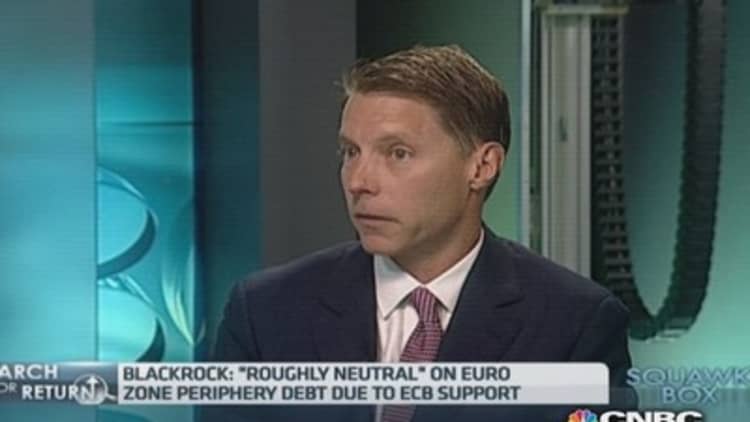With interest rates poised to rise, many U.S. investors are wary of bonds. But instead of pulling out, experts are urging people to look at relatively attractive fixed income products abroad, particularly in emerging markets.
"It's always hard to know exactly where to put your money these days given how rates and spreads are so low, but on a relative basis we still think there's value in EM debt," Matt Tucker, head of the iShares fixed income strategy team, said this week during a panel discussion at the Morningstar ETF Conference in Chicago.
BlackRock's iShares unit structures exchange traded fund products, including ones focused on international and emerging market bonds.
Read MoreEconomy weak due to 'stupid' policies: JPM's Kelly
Brian Evans, who runs ETF bond portfolios at Madrona Funds, said emerging markets were attractive by many measures, but were still cheap because of recent poor performance.
"Their economies are actually growing more than other economies, their quality rating is higher, the debt to GDP is much lower than the industrialized world. And their yields are higher," Evans said at the same Morningstar session. "All in all, that's an opportunity. That's called buying low."
Josh Barrickman, head of bond indexing at Vanguard, agreed.
"It's really attractive on a short-term income basis relative to alternatives and...the long-term prospects with demographics relative to the developed world and the sort of metrics that you would expect to generate improving economies," Barrickman said during the panel. "It's a very attractive place to be."
Barrickman acknowledged that recent crises in Ukraine and Argentina had frightened some investors in EM bonds but the market recovered quickly.
Those comments came after two conference keynote speakers also touted the value of EM debt. Russ Koesterich, BlackRock's chief investment strategist, recommended emerging market sovereign bonds because of the relatively low debt of the countries issuing them. And David Kelly, chief global strategist at JPMorgan Funds, said he liked emerging markets local debt. Both men generally preferred stocks over bonds.

The iShares JPMorgan USD Emerging Markets Bond fund, an index product that tracks the sector, has a trailing 12-month yield of 4.33 percent. Top holdings include bonds from Turkey, the Philippines and Colombia.
Despite the opportunity, not a lot of money has flowed into emerging market or international bond funds this year.
Emerging markets-focused bond mutual and ETF funds have only increased their assets by 1.72 percent in 2014, according to data from Morningstar, and manage just $86 billion. Funds that allocate to all types of international bonds manage $207 billion and gained 5.91 percent this year. By comparison, popular intermediate-term U.S. bond funds managed by PIMCO and others run $1.02 trillion, up 2.6 percent in net assets this year.
Investors may be generally overlooking international bonds.
"We've always thought that international bonds should be a large part of investors' portfolio," Barrickman of Vanguard said. "They make up about 35 percent of the capital markets, so it's a huge, huge asset class that has probably been under-represented for while."
Vanguard, Barrickman said, recommends investors have about 20 percent of their overall fixed income allocation in international bonds.
Read MoreNobel winner Fama: Active management 'never' good
Patricia Oey, a senior analyst at Morningstar who focuses on ETFs, said investors should be aware of volatility in emerging market bonds.
She said investors looking for smaller ups and downs should consider ETFs denominated in U.S. dollars or other so-called "hard currencies" that are seen as better stores of value. They typical yield around 4 percent while a 10-year U.S. Treasury bill yields 2.58 percent as of Friday.
Oey added that local currency EM bonds, which can yield around 7 percent, have "good long term fundamentals" including strengthening local bond markets, low debt, and faster GDP growth. But she said they "will likely be quite volatile" in the near term and are "probably not suitable for the average investor."





